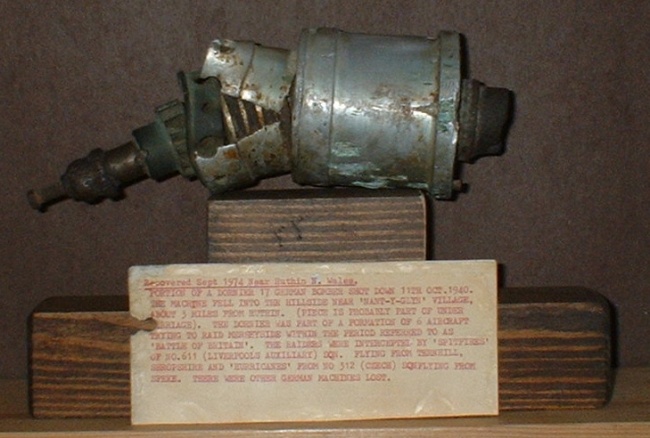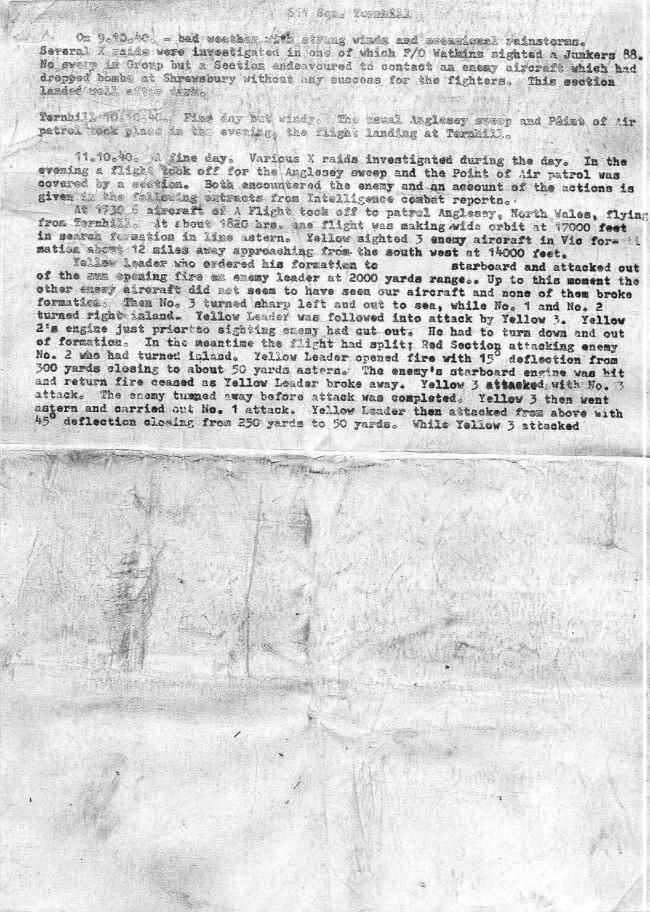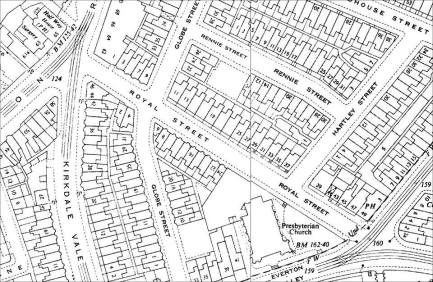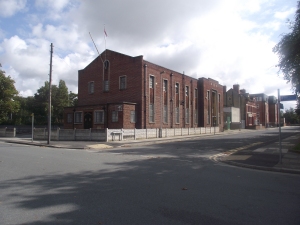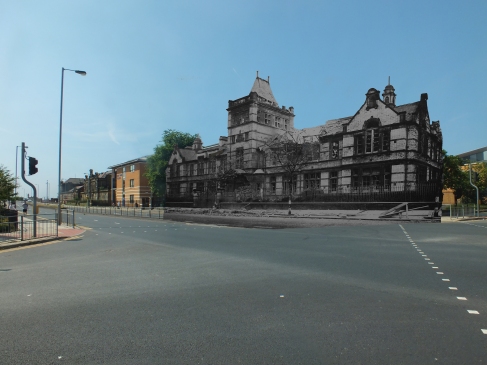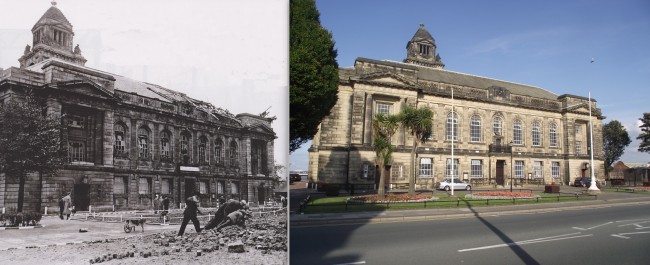Although not related to the Blitz, the following article is about an interesting aspect of local history. Written by me, it originally appeared in the quarterly newsletter for the friends of the Airborne Museum “Hartenstein”.

The photograph above is of a field grave of a British soldier in the Netherlands during WW2 which has appeared in several publications about the fighting in Arnhem. Until now relatively little was known about the paratrooper who was buried there, beyond his name, army number and date he fell. This article will provide a snapshot of one of the brave airborne soldiers who took part in the Market Garden Campaign.
My own connection to the story came about purely by chance. I live on the Wirral, a peninsula near to Liverpool, Wales and Chester. As a keen hiker I often enjoy walking through the nearby villages and towns and on one of these trips came across the tiny village of Shotwick. Located on the Dee Estuary, only 8 miles from Chester, it has a wonderful old church, in the grounds of which was the war memorial below with six names. One of these names stood out as unusual since it listed the date and place of death, something not normally seen on British memorials.

I noted down the details – “Frederick Walter Hopwood, killed in action at Arnhem, 18th September 1944” and decided to do some research when I got home. A quick internet search resulted in the photograph of Frederick’s field burial, along with information about where he had fallen. Strangely, the date on the war memorial contradicted the date on the field burial, which lead in turn to me wanting to find out much more about this man’s story.
One of the wreaths attached to the memorial included a dedication from “Sons Fred, Reg and surviving family members”. Through the Churchwarden I was able to contact Frederick’s family, eventually meeting his niece and having a long telephone conversation with his younger son. Their help and information was essential in compiling this article, as was support from a Dutch friend called Tom Timmermans who has also studied Frederick’s story and helped with some of the research.
Frederick was born on the 16th July 1917, the youngest of six children born to James and Emily Hopwood. In civilian life he worked as a train fireman at the local steelworks, a huge complex in the nearby town of Shotton which employed thousands of people and used more than 30 steam trains. Several members of his family also worked at the steelworks, as did many friends. The family lived at Bank Farm in Shotwick and worshipped at the church of St Michael’s in the village.
He enlisted in the army at Catterick Garrison on the 15th March 1940 and as was standard by then, signed up for “DOW” i.e. the duration of the war. At 5 feet 5 inches (165cm) he was shorter than average, but was also well built at 147lbs (67kg). He was also very athletic and enjoyed boxing.

An early photo of Frederick in Uniform, probably taken shortly after joining up.
His initial service was with an anti-aircraft unit, with which he was posted to various locations, including Whiltley Bay in the North East of England. Whilst serving there he met a local girl called Mabel and they were soon married. Returning to Cheshire, the family moved to a house in nearby Mollington. On the 14th May 1943 his first son, also called Frederick was born.
The exact details of when and where he served prior to Arnhem are uncertain, but some information can be deduced from surviving letters and documents in the family’s possession. Many of these were in a wallet that was recovered from his body by a chaplain shortly after he was killed (more on this later).
A British Army African campaign booklet, along with an Algerian 5 Franc Note confirms that he served in the Tunisian campaign that followed the Allied landings in Operation Torch. He also possessed several Italian notes, at least one of which was printed by the Allies, showing that he must have also served in either Sicily, Italy, or both.
Putting these notes together with the fact that he served with 3rd Battalion, the Parachute Regiment at Arnhem suggests that he was quite probably with the battalion since 1942, as it served in all of those places before being withdrawn to the United Kingdom in December 1943. Sadly his best friend, Reg Madeley was killed in Tunisia. Frederick’s second son, born two months after the battle of Arnhem would be named Reg in memory of that fallen friend.

A photograph of Frederick taken later in the war, probably in either Africa or Italy. On his right shoulder the jump wings that mark him out as a member of the Parachute Regiment can just be made out.
Along with the rest of 1st Airborne Division, Frederick’s battalion spent the next 9 months preparing for deployment in North West Europe. For Market Garden his unit dropped onto Drop Zone “X” at around 2pm on the 17th September 1944. After a brief delay whilst the battalion formed up, the troops moved off on their planned route to Arnhem. Named “Tiger” route, this would take it through Oosterbeek on the Utrechtseweg. Sadly this route would bring it into direct contact with a German blocking force under the command of SS Sturmbannfuhrer Sepp Krafft.
As the troops approached the junction of Utrechtseweg and Wofhezerweg they came under fire, initially from a self propelled flak gun and then from mortars and machine guns. What exactly happened to Frederick will probably never be known, but he almost certainly fell in this engagement. The damage to his wallet (seen below) and the documents within suggest that he was probably killed by a piece of shrapnel rather than a bullet. A chaplain recovered his belongings, keeping hold of them for most of the battle, no doubt hoping to return them to his next of kin.

He was buried where he fell, his Lee Enfield rifle placed in the ground to mark the spot. The tide soon turned against the paratroopers though and as we all know, the division eventually had to be evacuated across the Rhine. Along with many others, the chaplain volunteered to stay with the wounded, but passed his collection of belongings onto a pilot who had been shot down earlier in the fighting. The pilot was one of those lucky enough to get across the river and back to Allied lines, so was able to pass the possessions back to Frederick’s battalion.
In addition to the wallet was Frederick’s red beret, the iconic symbol of his elite status as a British paratrooper. Two smaller items were his identity disc, which gave his name and army number and an unusual badge. Given the stylised wings it would be easy to assume this was some form of regimental cap badge, but none like it exists in the British Army. After an extensive search online using the three visible letters “G T W” it turned out to be a membership badge for the Transport and General Workers Union, an organisation Frederick probably joined whilst he was working at the Steel Works.

The family knew none of this, as was usual during wartime since it was often difficult to obtain accurate casualty lists. Like many families, they received an initial notification from the War Office that he was listed as missing in action. In Frederick’s case this arrived in mid October 1944. Two months later they received his belongings in the post, the first real indication of his fate. They arrived on the very day that his second son was christened.

Frederick’s grave in Oosterbeek Cemetery. Photograph reproduced with the kind permission of Tom Timmermans
Official notification of his death from the War Office was not sent until June 1945, presumably after his field burial had been located. The photograph of the field grave was taken by a German photographer and first appeared in Berliner Illustrierte Zeitung in November 1944. The photographer was probably in the area at the time to see where General Kussin had been ambushed and killed, since Frederick’s grave is only a short distance away.

A modern view of the spot where Frederick Fell. The brick structure is a gate post for Hoog Oorsprong. Photograph reproduced with the kind permission of Tom Timmermans
For some reason the War Office recorded his death as occurring on the 18th September, which is unlikely as the battalion had moved further down Utrechtseweg by then. This official date was later used in formal documents, his grave in Oosterbeek Cemetery and on the War Memorial in Shotwick churchyard.
It is difficult for us to imagine how much of a shock Frederick’s death must have been to his family, friends and especially his young wife. Some indication of his popularity can be taken from the fact that his former colleagues at the Steelworks raised a total of £12.50 for Mabel and the children, a large sum in those days.
Like so many of his comrades in 1st Airborne Division he was eventually laid to rest in Oosterbeek Military Cemetery. His final resting pace is Plot 22, Row B, Grave 12. In 1966 Mabel remarried, but tragically died shortly after in a fire. Both sons are still alive and used to be regular visitors to the Arnhem area during the anniversary commemorations. They both speak very highly of the way that local people treat veterans, their families and the war graves.
The family are grateful for the opportunity to update Frederick’s story and make a wider audience aware of his sacrifice.














